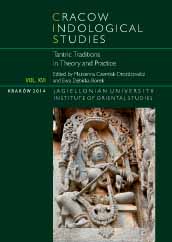Saiddhāntika paddhatis I. On Rāmanātha, the Earliest Southern Author of the Śaivasiddhānta of Whom Works Survive, and on Eleventh-century Revisions
Saiddhāntika paddhatis I. On Rāmanātha, the Earliest Southern Author of the Śaivasiddhānta of Whom Works Survive, and on Eleventh-century Revisions
Author(s): Dominic GoodallSubject(s): Cultural history
Published by: KSIĘGARNIA AKADEMICKA Sp. z o.o.
Keywords: Indian religious history; ritual manuals/paddhati; Śaivasiddhānta; Rāmanātha; Tiruvārūr; Sanskrit text-transmission
Summary/Abstract: The study of ritual in India is indissociable from the study of prescriptive texts. Now the Śaiva scriptures of the Śaivasiddhānta purport to lay down every aspect of the Śaiva religion, from doctrine to comportment, but they are for various reasons typically not straightforward guides to the performance of rituals and, in spite of their presenting themselves as revealed literature, they do not teach one body of ritual activity that is coherent and free from internal contradictions, as Śaiva exegetes have long freely acknowledged. One way of helping practitioners to perform rites ‘according to the rules’ was to write commentaries on particular scriptures. The tenth-century Kashmirian theologian Bhaṭṭa Rāmakaṇṭha, a back-to-the-texts fundamentalist at least in the matter of ritual correctness, clearly advocated this strategy and has left us commentaries on the ritual portions of the Mataṅgapārameśvaratantra and the Sārdhatriśatikālottara. Another strategy was to craft ritual handbooks, paddhatis, that clearly set out ritual practice step-by-step. Almost all surviving paddhatis, as Sanderson has observed (Sanderson 2004:358), are notionally based upon a single scripture, the Dviśatikālottara; but in practice this strategy gave ample room for innovation, typically by eclectic blending of ritual elements from different sources. A large number of Śaiva ritual manuals composed from the tenth century onwards survive (the best known are listed by Sanderson in his fn. 24 on p.358 of Sanderson 2004), only a few of which have been published to date. Because these manuals acknowledge themselves to be the works of human authors rooted in time and place, they can be of particular interest to the religious historian partly because they allow us to map the spread of different currents of Śaivism in time and place. Like the scriptures, they borrow generously from each other, thus demonstrating how they are mutually related. This article, to be followed by a few others on the same general theme, is intended as a small contribution to the history of Saiddhāntika paddhati literature.
Journal: Cracow Indological Studies
- Issue Year: 2014
- Issue No: 16
- Page Range: 169-201
- Page Count: 33

